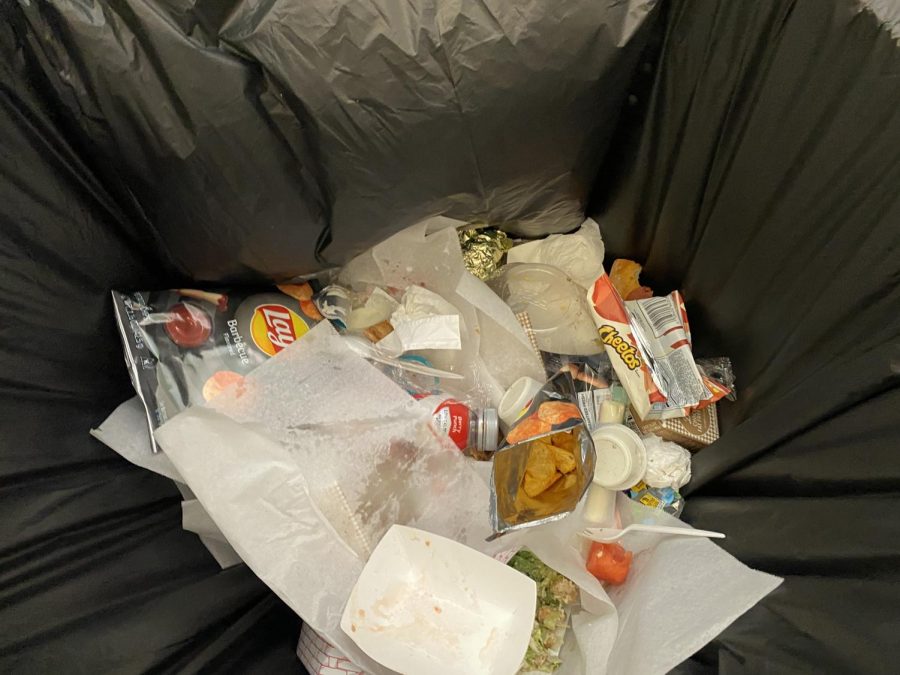2012-2013 marked the first school year of Michelle Obama’s new food program. While this required healthier options for students, it resulted in nearly 50 percent of food on students’ plates to go to waste daily.
The same epidemic of food waste can be found in PV schools across the district. In high school, students have the freedom to choose what they would like for lunch. They are not required to follow the same meal plan that younger students do.
Elementary schools must require the students to get a grain, a source of protein, vegetables, fruit and dairy on their plates. For pickier elementary students, this is more than enough food for them to choose from, and more often than not, the majority is going to waste.
In high school, students are given a wider variety of lunch options to choose from: salad, sandwiches, main dish, alternative, another alternative and more. This list does not even include the numerous sides made available to the students. With all these options readily available, it can be a little overwhelming for students. They are often inclined to take more food then they will actually end up eating.
Food waste of any sort is especially detrimental to the people and the environment.
Many people in the US suffer from food poverty, which is why it is so devastating to see food waste happening in schools. On average, Feeding America, a United States based nonprofit food-bank, provides meals to more than 4.3 billion people annually.
When food waste and general trash gets carried away from schools, it ends up in landfills. The US Environmental Protection Agency identified food as one of the single largest contributors to greenhouse gas emissions in landfills. Like many other things, when the food breaks down, it releases methane gases that are extremely harmful to the environment.
Along with students wasting their food, PV is unable to recycle as many things as many would think. There is a great deal of work being done to reduce the amount of waste produced, but as a school that is short staffed, there are limited resources.
Paper trays and bowls on top of the plastic trays were first introduced at the junior high. Prior to this, the food provided for lunch was placed directly onto a sectioned tray. Whether the food was placed directly on the tray, or within a paper tray on the plastic tray the plastic tray will end up needing to be washed. If both items will be getting washed in the long run, what benefit do the paper and plastic dishes provide?
Principal Darren Erickson discussed the issue with reusable dishes, which is related to staffing. “We don’t have the staffing and area to accommodate literally thousands of plates, silverware, and other items. This is why we encourage students to only take what they have and do their part in reducing waste,” he said. Sometimes, parents and students develop the misconception that PV is just ignoring the issues they have with waste, but luckily that is not always the case.
Great strides have been made in the last few years as described by kitchen manager Aaron Shannon. “We have tried to replace as much of the plastic as possible. The paper boats and cups are biodegradable,” he said. By taking precautions like these, the staff has shown the student body that these concerns are not being disregarded.
While many biodegradable products still release methane and other detrimental greenhouse gases, the quantity of gases they produce is significantly lessened. Still, there is more that can be done.
On a smaller scale, one person throwing away their extra food does not seem that bad, but consider a cafeteria filled with hundreds of students. Say there were 150 students in the cafeteria who all got hot lunch that day; each person throws away about half of the food they originally picked up. Seventy-five meals will now be going to waste because students did not take their time as they went through the lunch line.
PV has no guidelines about seconds or thirds. Students are able to eat what is on their plate, and if they are still hungry, they are welcome to go back up and buy more. If every student tried to be just a little more aware of the food they were taking and wasting, the numbers could be reduced.
Everyday students and staff are coming up with more ways to try and run a school in a more sustainable manner. There is never just one solution to the problem. PV student body, consider your waste.









